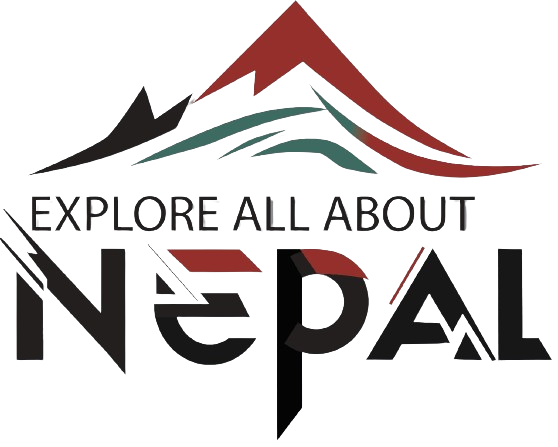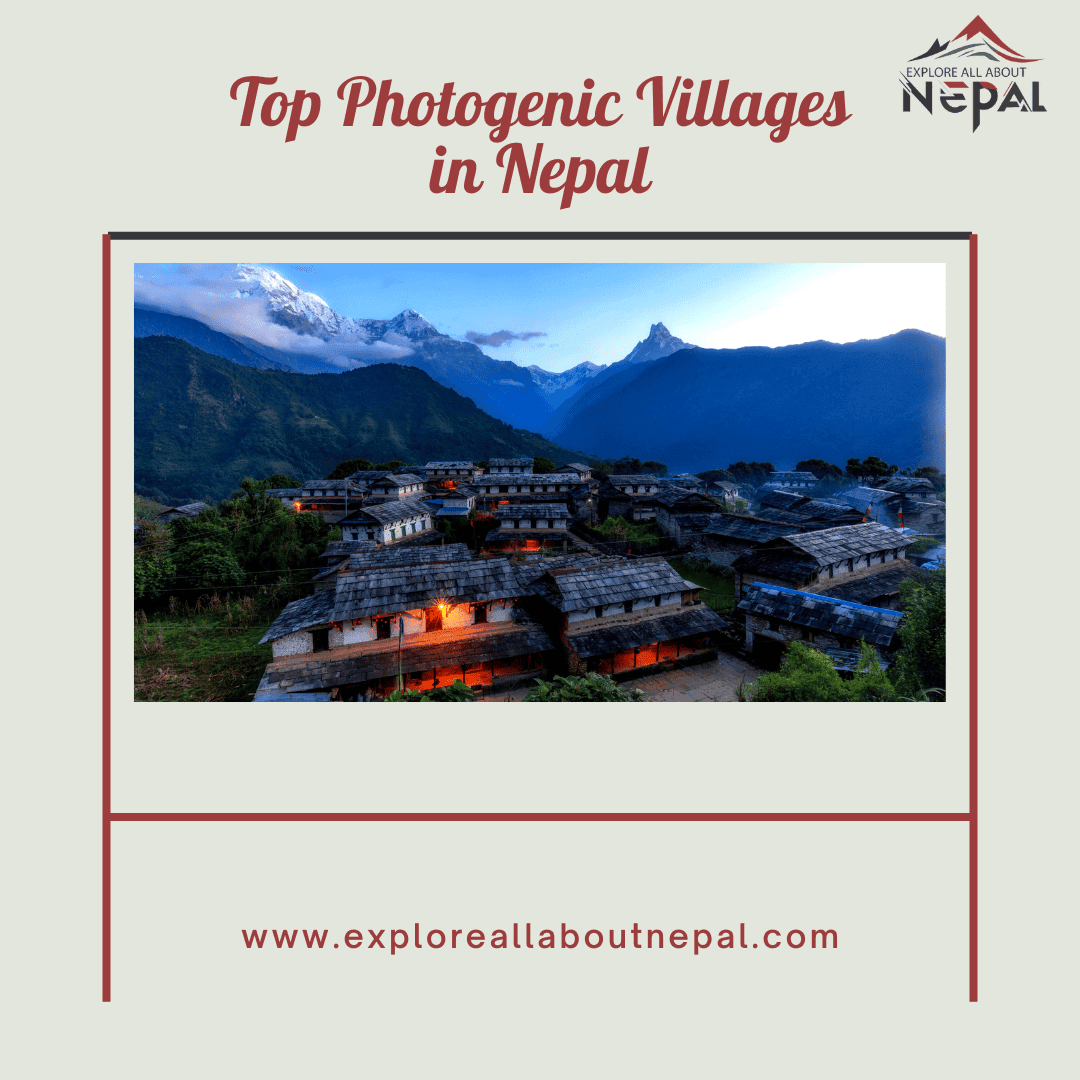Photogenic Villages in Nepal refers to villages that possess visually striking, picturesque characteristics that make them ideal subjects for photography. These villages often feature breathtaking landscapes, traditional architecture, vibrant culture, and scenic backdrops like snow-capped mountains, terraced fields, rivers, and forests. The charm of these villages lies in their natural beauty, peaceful atmosphere, and unique local lifestyle, offering photographers and tourists a chance to capture stunning images. Examples of such villages include Ghandruk, Bandipur, and Sauraha, which are known for their charm and incredible photo opportunities.
Nepal, a land of breathtaking landscapes, is home to some of the most picturesque villages in the world. Nestled amidst the Himalayas, these villages offer stunning views, unique cultural experiences, and a peaceful escape from city life. From the snow-capped peaks of the Annapurna region to the lush green hills of the eastern highlands, each village has its own charm, making them a must-visit for travelers and photographers alike.
In this blog, we will explore Nepal’s most photogenic villages, detailing how to get there, key attractions, estimated budget, and travel tips for tourists.
Top Photogenic Villages in Nepal
1.Ghandruk Village

How to Get There:
- Fly or drive from Kathmandu to Pokhara
- Take a bus or jeep from Pokhara to Nayapul (1.5 hours)
- Hike from Nayapul to Ghandruk (4-5 hours)
Key Attractions:
- Traditional Gurung culture and houses
- Stunning views of Annapurna South, Hiunchuli, and Machapuchare
- Ghandruk Museum showcasing Gurung heritage
- Rhododendron forests and scenic trails
Estimated Budget:
- Transportation: $15-$30 (bus/jeep)
- Accommodation: $10-$30 per night
- Meals: $5-$10 per meal
2. Bandipur Village
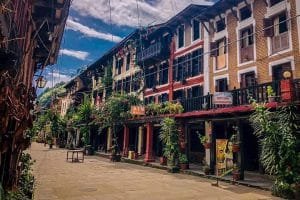
How to Get There:
- Drive or take a bus from Kathmandu or Pokhara (4-5 hours)
Key Attractions:
- Well-preserved Newari architecture
- Panoramic views of the Annapurna and Langtang ranges
- Thani Mai Temple for sunrise views
- Siddha Gufa, Nepal’s largest cave
Estimated Budget:
- Transportation: $10-$20 (bus)
- Accommodation: $15-$40 per night
- Meals: $5-$15 per meal
3. Dhampus Village
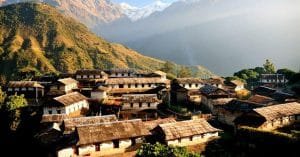
How to Get There:
- Fly or drive from Kathmandu to Pokhara
- Drive to Phedi (30 minutes)
- Hike from Phedi to Dhampus (2-3 hours)
Key Attractions:
- Stunning views of Annapurna, Dhaulagiri, and Machapuchare
- Terraced fields and traditional Gurung culture
- Ideal spot for sunrise and sunset photography
Estimated Budget:
- Transportation: $10-$30 (bus/taxi)
- Accommodation: $10-$25 per night
- Meals: $5-$10 per meal
4. Marpha Village

How to Get There:
- Fly from Pokhara to Jomsom (25 minutes)
- Hike or take a jeep from Jomsom to Marpha (1-2 hours)
Key Attractions:
- Famous for apple orchards and apple-based products
- Whitewashed houses and narrow stone-paved streets
- Ancient Buddhist monasteries
- Stunning views of Nilgiri and Dhaulagiri
Estimated Budget:
- Transportation: $30-$100 (flight/jeep)
- Accommodation: $10-$30 per night
- Meals: $5-$15 per meal
5. Kagbeni Village
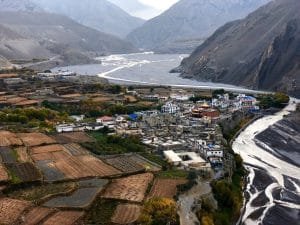
How to Get There:
- Fly from Pokhara to Jomsom
- Drive or hike from Jomsom to Kagbeni (2-3 hours)
Key Attractions:
- Gateway to Upper Mustang
- Traditional Tibetan-style houses and monasteries
- Panoramic views of the Kali Gandaki River
- Historical significance in Tibetan and Nepalese culture
Estimated Budget:
- Transportation: $30-$100 (flight/jeep)
- Accommodation: $10-$35 per night
- Meals: $5-$15 per meal
6. Chitlang Village

How to Get There:
- Drive from Kathmandu (2-3 hours)
- Hike from Thankot or take a cable car to Chandragiri and then drive
Key Attractions:
- Green terraced fields and stunning landscapes
- Organic farms and goat cheese factory
- Historical temples and stone inscriptions
Estimated Budget:
- Transportation: $5-$15 (bus/taxi)
- Accommodation: $10-$25 per night
- Meals: $5-$10 per meal
7. Sirubari Village
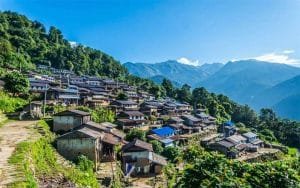
How to Get There:
- Drive or take a bus from Pokhara to Arjunchaupari (4-5 hours)
- Hike to Sirubari (2 hours)
Key Attractions:
- Nepal’s first model homestay village
- Authentic Gurung cultural experience
- Clean and peaceful environment with terraced fields
Estimated Budget:
- Transportation: $15-$30 (bus/jeep)
- Accommodation: $10-$20 per night
- Meals: $5-$10 per meal
8. Tansen (Palpa)
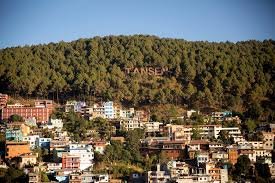
How to Get There:
- Drive or take a bus from Pokhara or Kathmandu (5-6 hours)
Key Attractions:
- Traditional Newari architecture
- Stunning views of the Himalayas and the Terai region
- Rani Mahal, known as the Taj Mahal of Nepal
Estimated Budget:
- Transportation: $10-$20 (bus)
- Accommodation: $10-$30 per night
- Meals: $5-$10 per meal
9. Lo Manthang (Upper Mustang)
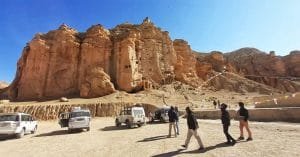
How to Get There:
- Fly from Pokhara to Jomsom
- Drive or trek to Lo Manthang (3-5 days trek)
Key Attractions:
- Ancient walled city with Tibetan influence
- Stunning landscapes of the Upper Mustang desert
- Ancient monasteries and caves
Estimated Budget:
- Transportation: $100-$300 (flights/jeep)
- Accommodation: $20-$50 per night
- Meals: $10-$20 per meal
10. Namche Bazaar
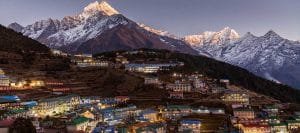
How to Get There:
- Fly from Kathmandu to Lukla
- Trek from Lukla to Namche Bazaar (2-3 days)
Key Attractions:
- Gateway to Everest Base Camp
- Stunning views of Everest, Lhotse, and Ama Dablam
- Bustling market town with Tibetan handicrafts
Estimated Budget:
- Transportation: $150-$300 (flight)
- Accommodation: $15-$50 per night
- Meals: $5-$15 per meal
Travel Tips for Tourists:
- Best Time to Visit: Spring (March-May) and Autumn (September-November) offer clear skies and pleasant weather.
- Packing Essentials: Comfortable trekking shoes, warm clothing, rain gear, and a good camera.
- Cultural Etiquette: Respect local traditions and dress modestly, especially in religious sites.
- Accommodation: Homestays provide a better cultural experience and are budget-friendly.
- Permits: Some villages, especially in Mustang and Everest regions, require special trekking permits.
- Food & Water: Try local food but stick to bottled or purified water.
- Connectivity: Internet and phone signals may be weak in remote areas, so inform family before traveling.
- Local Transport: Hiring a local guide or porter can enhance your experience and help navigate better.
- Budget Planning: Keep extra cash as ATMs may not be available in remote villages.
- Sustainability: Avoid plastic waste and respect the environment by following eco-friendly travel practices.
Highlights
Conclusion
Nepal’s villages offer an incredible mix of natural beauty, cultural heritage, and adventure. Whether you’re exploring the traditional Gurung culture of Ghandruk, the desert landscapes of Lo Manthang, or the apple orchards of Marpha, each village has something unique to offer. With well-planned travel, an open heart, and a camera in hand, these photogenic villages will leave you with unforgettable memories.
